Upside Down in the Middle of Nowhere will appeal to young people who have had to cope with catastrophe and its aftermath.
Add a CommentViewing: Blog Posts Tagged with: Hurricane Katrina, Most Recent at Top [Help]
Results 1 - 16 of 16
Blog: The Children's Book Review (Login to Add to MyJacketFlap)
JacketFlap tags: Multicultural, Ages 9-12, Chapter Books, Chronicle Books, Middle Grade Books, Hurricane, Hurricane Katrina, Juliet T. Lamana, Add a tag
Blog: OUPblog (Login to Add to MyJacketFlap)
JacketFlap tags: COP21, Climate Change and Public Health, Jonathan A. Patz, Books, Politics, climate change, Hurricane Katrina, renewable energy, public health, food security, greenhouse gases, Barry S. Levy, *Featured, Science & Medicine, Health & Medicine, Extreme Weather, environmental science, Superstorm Sandy, Earth & Life Sciences, Add a tag
When heads of state and other leaders of 195 nations reached a landmark accord at the recent United Nations COP21 conference on climate change in Paris, they focused primarily on sea level rise, droughts, loss of biodiversity, and ways to decrease greenhouse gas emissions in order to reduce these consequences. But arguably the most serious and widespread impacts of climate change are those that are hazardous to the health of people.
The post Climate change poses risks to your health appeared first on OUPblog.
Blog: Shelf-employed (Login to Add to MyJacketFlap)
JacketFlap tags: YA, nonfiction, New Orleans, J, floods, hurricanes, Hurricane Katrina, Add a tag
 The National Council of Teachers of English recently named Drowned City: Hurricane Katrina & New Orleans by Don Brown (Houghton Mifflin Harcourt, 2015) the winner of its prestigious Orbis Pictus Award.
The National Council of Teachers of English recently named Drowned City: Hurricane Katrina & New Orleans by Don Brown (Houghton Mifflin Harcourt, 2015) the winner of its prestigious Orbis Pictus Award.
The NCTE Orbis Pictus Award was established in 1989 for promoting and recognizing excellence in the writing of nonfiction for children. The name Orbis Pictus, commemorates the work of Johannes Amos Comenius, Orbis Pictus—The World in Pictures (1657), considered to be the first book actually planned for children. (from the NCTE website)
Drowned City: Hurricane Katrina & New Orleans is a spare, but powerful graphic novel account of the tragedy that befell the City of New Orleans following Hurricane Katrina. Don Brown researches and illustrates Drowned City in his usual fashion. It has extensive Source Notes and a corresponding Bibliography. Every direct quote is sourced. The illustrations are serious and in muted colors to accurately convey the gravity of the events; but they are sufficiently vague to spare the individual horror experienced by victims, survivors, and rescuers. As he has done with other topics, Don Brown creates a focused, accurate, and powerful story - suitable for visual learners and for readers in a wide age range.
Other Hurricane Katrina books reviewed on this site:
Also by Don Brown and reviewed by Shelf-employed:
- America is Under Attack: September 11, 2001: The Day the Towers Fell
- The Great American Dust Bowl
- All Stations! Distress!: April 15, 1912: The Day the Titanic Sank
- Let it Begin Here!: April 19, 1775: The Day the American Revolution Began
Blog: OUPblog (Login to Add to MyJacketFlap)
JacketFlap tags: Historic New Orleans Collection, Hurricane Katrina Interviews, Impact of Hurricane Katrina, New Orleans Revival, Oral History in the Aftermath of Crisis, Oral History of Hurricane Katrina, Oral History of Natural Disasters, Oral History of New Orleans, Post-Katrina New Orleans, Books, America, Hurricane Katrina, Oral History, *Featured, Listening on the Edge, Mark Cave, Add a tag
Ten years have passed since Katrina. New Orleans is in the midst of celebrating a remarkable renewal. I still live in the same apartment that I lived in before the storm. It looks the same, perhaps a bit more cluttered, but the neighborhood has certainly changed.
The post Ghosts of Katrina appeared first on OUPblog.
Blog: Kid Lit Reviews (Login to Add to MyJacketFlap)
JacketFlap tags: Children's Books, Picture Book, joy, Historical Fiction, Favorites, Chronicle Books, John Parra, Phil Bildner, Hurricane Katrina, writing technique, repetition, alliteration, community spirit, 5stars, Library Donated Books, folklores, Marvelous Cornelius: Hurricane Katrina and the Spirit of New Orleans, Katrina's Children, Cornelius Washington, exageration, Add a tag
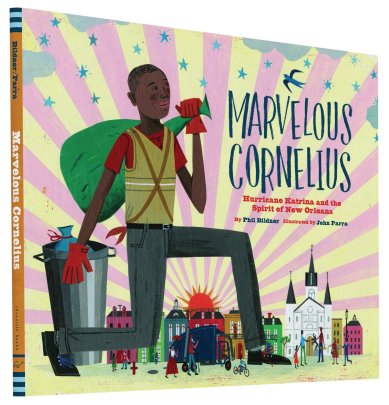
Marvelous Cornelius: Hurricane Katrina and the Spirit of New Orleans
Written by Phil Bildner
Illustrated by John Parra
Chronicle Books 8/04/2015
978-1-4521-2578-7
44 pages Age 3—5
“In New Orleans, there lived a man who saw the streets as his calling, and he swept them clean. He danced up one avenue and down another and everyone danced along—The old ladies whistled and whirled. The old men hooted and hollered. The barbers, bead twirlers, and beignet bakers bounded behind that one-man parade. But then came the rising Mississippi—and a storm bigger than anyone had seen before. Phil Bildner and John Parra tell the inspirational story of a humble man, and the heroic difference he made in the aftermath of Hurricane Katrina.” [inside jacket]
Review
Marvelous Cornelius, the person, embodies the best of us. Day-to-day he performed his job—one many would consider unglamorous—with dignity, enthusiasm, and a spirit of giving to those he served. People responded positively to this larger-than-life man. Kids enjoyed his spirited antics. When disaster struck in the name of Hurricane Katrina, this French Quarter-New Orléans resident went to work cleaning up his city with the same joyousness as before, only this time, the residents responded not only with enjoyment to see their local “hero,” but pitched in following his lead. Together—including many volunteers from outside of New Orléans—Marvelous Cornelius led his neighbors in cleaning up their beloved city. Just as he did on his daily job, Marvelous Cornelius helped keep New Orléans clean, for he was a garbage man by trade; garbage man extraordinaire.
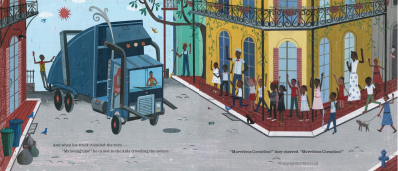 With the use of many writing techniques—alliteration, repetition, and exaggeration—author Bildner keeps the story lively. Children will enjoy Cornelius Washington’s story of how an ordinary citizen can help keep their city or town upbeat, their neighbors friendly and joyous, and their streets clean, making for a wonderful place to live.
With the use of many writing techniques—alliteration, repetition, and exaggeration—author Bildner keeps the story lively. Children will enjoy Cornelius Washington’s story of how an ordinary citizen can help keep their city or town upbeat, their neighbors friendly and joyous, and their streets clean, making for a wonderful place to live.
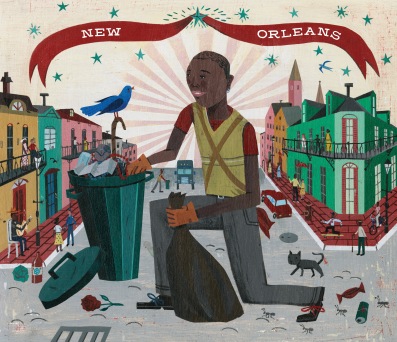 At times, the illustrations portray Marvelous Cornelius as a literal giant emphasizing his larger-than-life persona. He becomes more realistic when portrayed with the residents he served. I would have liked to have seen a more multicultural representation of the residents of New Orléans, though artist Parra may have decided to show a true representation of the resident’s Cornelius Washington actually served. Of note: the illustrations do show a multicultural people once the city is swept clean of the “gumbo of mush and mud.”
At times, the illustrations portray Marvelous Cornelius as a literal giant emphasizing his larger-than-life persona. He becomes more realistic when portrayed with the residents he served. I would have liked to have seen a more multicultural representation of the residents of New Orléans, though artist Parra may have decided to show a true representation of the resident’s Cornelius Washington actually served. Of note: the illustrations do show a multicultural people once the city is swept clean of the “gumbo of mush and mud.”
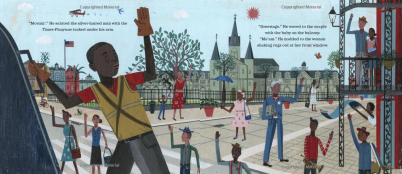 The art is a delight with its rustic feel and animations of Cornelius “Tango-ing up Toulouse” and “Samba-ing down St. Peter.” I loved the changing text size and font when Marvelous Cornelius sang out his familiar calls:
The art is a delight with its rustic feel and animations of Cornelius “Tango-ing up Toulouse” and “Samba-ing down St. Peter.” I loved the changing text size and font when Marvelous Cornelius sang out his familiar calls:
“WOO! WOO! WOOOOO! WOO! WOO! WOOOOO!”
“RAT-A-TAT-TAT RAT-A-TAT-TAT
“HOOTIE HOO! HOOTIE HOOOOO! SHOWTIME!”
At story’s end, the author writes more about New Orléans, its people, and Hurricane Katrina (which brought major devastation to this coastal city). Bildner also delves into his writing style, saying his use of alliteration, repetition, and exaggeration helped him write Cornelius Washington’s story as a folktale, similar to that of John Henry. Together with artist Parra, Bildner has succeeded in writing a story every child should read and will most definitely enjoy. Teachers can find many lessons in Mr. Washington’s story of an average person who rose to heroic heights simply by doing his best every day.
MARVELOUS CORNELIUS: HURRICANE KATRINA AND THE SPIRIT OF NEW ORLEANS. Text copyright © 2015 by Phil Bildner. Illustrations copyright © 2015 by John Parra. Reproduced by permission of the publisher, Chronicle Books, San Francisco, CA.
Purchase Marvelous Cornelius: Hurricane Katrina and the Spirit of New Orleans at Amazon—Book Depository—iTunes Books—Chronicle Books.
Learn more about Marvelous Cornelius: Hurricane Katrina and the Spirit of New Orleans HERE.
Find a Common Core-Aligned Teacher’s Guide HERE.
Read more about Katrina’s Children HERE.
Watch the full length video Katrina’s Children free HERE.
Meet the author, Phil Bildner, at his website: http://philbildner.com/
Meet the illustrator, John Parra, at his website: http://www.johnparraart.com/
Find more picture books at the Chronicle Books website: http://www.chroniclebooks.com/
Copyright © 2015 by Sue Morris/Kid Lit Reviews. All Rights Reserved
Full Disclosure: Marvelous Cornelius: Hurricane Katrina and the Spirit of New Orleans, by Phil Bildner & John Parra, and received from Chronicle Books, is in exchange NOT for a positive review, but for an HONEST review. The opinions expressed are my own and no one else’s. I am disclosing this in accordance with the Federal Trade Commission’s 16 CFR, Part 255: “Guides Concerning the Use of Endorsements and Testimonials in Advertising.”
Filed under: 5stars, Children's Books, Favorites, Historical Fiction, Library Donated Books, Picture Book Tagged: alliteration, Chronicle Books, community spirit, Cornelius Washington, exageration, folklores, Hurricane Katrina, John Parra, joy, Katrina's Children, Marvelous Cornelius: Hurricane Katrina and the Spirit of New Orleans, Phil Bildner, repetition, writing technique
Blog: Miss Marple's Musings (Login to Add to MyJacketFlap)
JacketFlap tags: picture books, New Orleans, Hurricane Katrina, Perfect Picture Book Friday, FedEx, Lisa Anchin, PPBF, teaching activities & resources, A PENGUIN NAMED PATIENCE A HURRICANE KATRIAN RESCUE STORY, Suzanne Lewis, penguins, Add a tag
Title: A Penguin Named Patience, A Hurricane Katrina Rescue Story Written by: Suzanne Lewis Illustrated by: Lisa Anchin Published by: Sleeping Bear Press, 2015 Themes/Topics: Hurricane Katrina, penguins, rescuing, patience Suitable for ages: 3-7 Opening: Patience knew something was terribly wrong. It was dark and steamy … Continue reading
Add a CommentBlog: Ink Splot 26 (Login to Add to MyJacketFlap)
JacketFlap tags: hurricane katrina, Reads, rodman philbrick, zane and the hurricane, Add a tag
Zane and the Hurricane: A Story of Katrina (for ages 9-14) by Rodman Philbrick
Zane Dupree is against the trip to New Orleans (a.k.a Smellyville). Zane’s father died before he was born, so he doesn’t know much about his past. It isn’t until Zane is twelve that his mom finds Miss Trissy, the woman who raised his dad. Zane’s mom wants him to go back to his roots for a week. He only agrees to go if he can bring his best friend, his dog Bandit.
Surprisingly, once he arrives in New Orleans, Zane takes an immediate liking to Miss Trissy. Despite being ancient and not having a working television or air conditioning, Miss Trissy does what she can to make Zane happy. She tells him stories of his dad growing up; they look through old pictures, and they eat ice cream on the porch. The week passes by quickly until word of a hurricane heading their way changes it all.Once the storm hits, things happen quickly. The whole city becomes flooded and Zane finds himself separated from Miss Trissy and stranded in an attic with Bandit, to be rescued by Mr. Tru and Malvina in a green canoe. They scour the city, hoping to find a place to survive the flooded aftermath of a devastating storm.
Will Zane be able to survive the storm? Will he be reunited with his mom and Miss Trissy? Read and find out! Then leave a comment with your thoughts and feelings below!
—Elysse, STACKS Writer
Add a CommentBlog: OUPblog (Login to Add to MyJacketFlap)
JacketFlap tags: History, US, Hurricane Katrina, oral history, *Featured, Hurricane Sandy, Oral History Review, Caitlin Tyler-Richards, disaster zones, Jennifer Abraham Cramer, cramer, Add a tag
By Caitlin Tyler-Richards
When Superstorm Sandy hit the United States’ east coast in late October, I was struck by the way in which oral historians and other like-minded academics responded to the ensuing chaos. This was not the first time I had seen oral history interact with natural disaster; one of the first articles I prepped for our Twitter feed was KUT News’ “Forged in Flames: An Oral History of the Labor Day Wildfires,” a multi-media documentation of the wildfires that overtook Texas in September 2011. However, to see the response in real time was a completely different experience.
Almost immediately, social media like the Storify stream set up by the Brooklyn Historical Society (@brooklynhistory) and hundreds of unbelieveable — and just plain untrue — instagram photos coalesced into a haphazard digital archive. More cohesive and comprehensive accounts, like Mike Chaban’s “The Committee to Save New York: An Oral History of Hurricane Sandy” and Carol Hill Albert’s “Coney Island Stories: Category One” appeared soon after. This rapid fire, occasionally heart-rending coverage led me to think more deeply on how oral historians in particular address major, traumatic events like Superstorm Sandy. Does one go to the damaged areas with the intention of conducting official, project-motivated Oral History Research (TM); or are the goals more personal and therapeutic? How, if at all, do one’s tactics change when conducting interviews with recent trauma survivors?
I didn’t have to go far for further insight. In addition to serving as our media review editor, Jennifer Abraham Cramer is the director of Louisiana State University’s T. Harry Williams Center for Oral History. She has worked on a number of oral history projects, including one on Hurricanes Katrina and Rita in 2005. We started off with what I thought was an easy question, “How did you become involved in post-Katrina research?”:
I was very reluctant to become involved with post-Katrina research, initially. Starting an oral history project in 2005 didn’t feel right to me—my husband’s family is from New Orleans, and we were still very much going through Katrina and Rita. Doing oral histories of a current event didn’t make a lot of sense to me at the time. Plus, I wondered, “Why spend time interviewing people about recent events when people who witnessed more distant events that are equally significant to our nation’s history are passing away, and taking their stories and memories with them?” I was also concerned about legal ramifications (ongoing court cases, criminal investigations, insurance claims, etc.) where respondents were discussing very recent events. Then, of course, the big issue with doing oral history projects around crisis events is that you don’t want to further traumatize your interviewee, exploit them, or paint them as helpless victims.
Despite her reservations, Cramer and the Williams Center decided to get involved with post-Katrina and Rita research, largely to ensure that the numerous oral history projects already in the works would follow the Oral History Association’sprinciples and best practices. If people were going into the field anyway, the Williams Center could ensure that the interviews they conducted “would be well-done, archived, and available to researchers.”
Given the concerns she expressed, I was curious to know what, if any obstacles Cramer faced during interviews, and if these challenges forced her to change her interview strategy. Here, especially as a historian-in-training, I was intrigued by the unique challenges post-Katrina research posed, and the manner in which Cramer thought through them:
The two big challenges were documenting recent events and conducting interviews with people who had recently experienced trauma. So firstly, using oral history methodology to document recent events is a bit challenging because of the different ways that people recall recent and past events. The brain has integrated causal relationships for distant happenings, but is more focused on the rich details of the “how” and “what” when it comes to more recent memories, thus affecting the way that respondents answer questions. Stories of recent events are a bit more scattered and thick with details, so you have to adjust your interviewing methodology.
Secondly, you have the challenge of interviewing people who have recently experienced crises. Trauma in oral histories is nothing new. For example, in the recording of a life narrative from a person who grew up in the 1930s and 40s in South Louisiana, it is likely that their story would include experiences with the 1927 Flood and the Great Depression. If they went to war, then you may have wartime violence and PTSD in a post-war America gearing up for a possible nuclear attack. Any oral historian conducting a life narrative interview will most definitely re-live a trauma with their interviewee. Most of these stories come naturally in the flow of the interview and are not necessarily the focus of the interview itself, and the narrator has integrated the trauma into their overall life story.
What was different about the Katrina and Rita interviews was that interviewees and even some interviewers were still living through the crises they were trying to document, and had not yet integrated those new hardships into their life story. This a major part of healing from PTSD and takes time. Thus, it became imperative to learn about the best way to conduct oral histories in the aftermath of crisis. I consulted my fellow oral historians located in the Gulf Coast region, and also sought advice from Mary Marshall Clark who had extensive experience documenting recent trauma with her project out of Columbia University, “September 11, Oral History, Memory and Narrative Project.” I also consulted professionals in the field of psychology about PTSD and interviewing. From all of this, I was able to outline some ethical considerations for interviewers here on the ground.
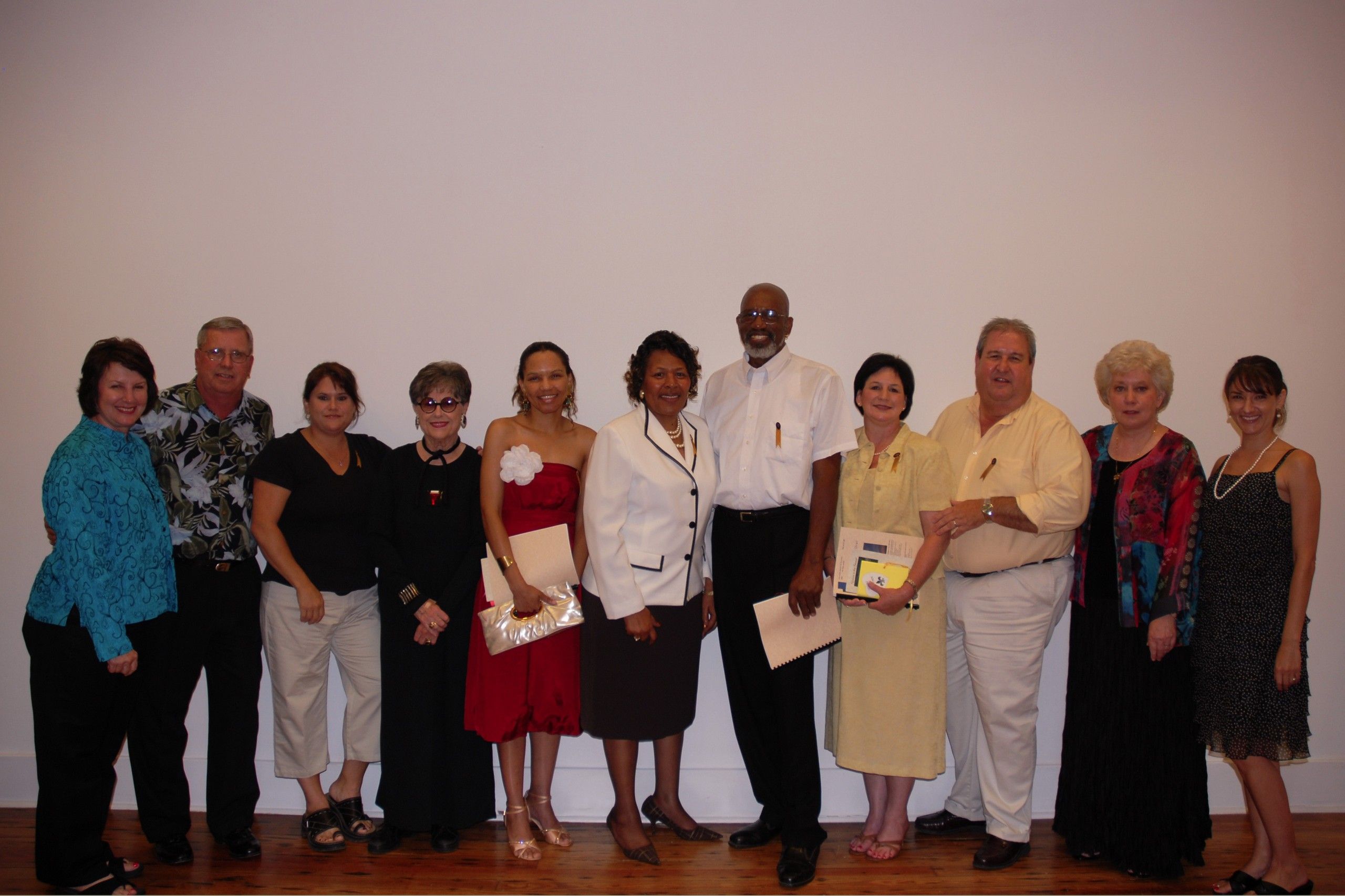
Taken at a reception held in 2007 to honor the interviewees who participated in the “Voices in the Storm Oral History Project,” sponsored by the Julien Poydras Museum Arts Council in Pointe Coupee Parish. Those photographed include 8 interviewees and 3 interviewers, including interviewee Jen Abraham Cramer (far right). The project documents stories of those who relocated from New Orleans to New Roads, Louisiana, in the aftermath of Hurricane Katrina. New Roads is one of the oldest settlements in Louisiana and has long-standing historic and cultural ties to the city of New Orleans. The Williams Center consulted in the design and implementation of the project and houses the collections at the Center in the LSU Libraries Special Collections.
While recognizing that new memories, especially those of recent trauma survivors, carry a raw, emotional and largely unprocessed weight to them, Cramer did not have any illusions regarding the healing power her interviews might provide:
There is no doubt that story-telling can be therapeutic. But, we as oral historians are trained to document while therapists are trained in their field with entirely different goals. Oral historians record stories that offer experiential information in order to create primary sources that are preserved and made available to the public. It is wonderful when, through the course of an oral history interview, we can help the interviewee heal as perhaps part of their therapy, but I believe that it’s best for oral historians to stick to the overall goal of documenting — while being especially careful with respondents who have recently experienced trauma.
I closed our e-exchange with the most pragmatic question, “Any advice for those conducting oral history projects following natural disasters?” — the answer to which I hope everyone will print out and tape to their walls:
Basically the guidelines I mentioned earlier: It may be helpful to seek training from professionals in the field of psychology, if possible. For the purposes of our projects at the Center in the aftermath of Hurricanes Katrina and Rita, the Red Cross provided lists of what not to say to survivors of disasters, which I in turn provided to interviewers. I encouraged interviewers to conduct life narratives so that the hurricane story was situated within a larger context—this included previous storm stories like Hurricane Betsy. I also encouraged them to stay away from asking about emotions and feelings, and to focus more on what the interviewee experienced and witnessed, yet to be compassionate when emotions arose. Interviewers were encouraged to honor the interviewees in some way—whether at a community event or in a final product given to the interviewees, and to include them in every step of the project.
Most importantly, the interviewers were encouraged to follow up on their interviews five years or ten years later to create a longitudinal documentation and commemoration. In addition, I incorporated Clark’s suggestions to ensure that interviewers have certain training and skills: the ability to connect emotionally to the narrator and to create a supportive listening environment; to be concerned, but not intrusive; to connect interviewees with each other; and to ask questions that may help the interviewee with explanatory stories.
As always, we’ll close here by turning it over to our readers. Have any of you conducted research following natural disasters and have insights you’d like to share? Or do you have a project in mind and need more advice on how to tackle some of the obstacles Cramer mentioned? To the comments, everyone!
Jennifer Abraham Cramer is the Director of Louisiana State University’s T. Harry Williams Center for Oral History, where she manages multiple ongoing staff and partner projects and oversees the processing, preservation, digitization, and public access of the Center’s 5,000 hours of audio recordings. She is the creator and producer of the Center’s podcast, “What Endures,” and currently serves as the media review editor for The Oral History Review.
Caitlin Tyler-Richards is the editorial/ media assistant at the Oral History Review. When not sharing profound witticisms at @OralHistReview, Caitlin pursues a PhD in African History at the University of Wisconsin-Madison. Her research revolves around the intersection of West African history, literature and identity construction, as well as a fledgling interest in digital humanities. Before coming to Madison, Caitlin worked for the Lannan Center for Poetics and Social Practice at Georgetown University.
Subscribe to the OUPblog via email or RSS.
Subscribe to only history articles on the OUPblog via email or RSS.
The post Oral history in disaster zones appeared first on OUPblog.
Blog: Book Love (Login to Add to MyJacketFlap)
JacketFlap tags: fantasy, ghost story, MG, Hurricane Katrina, PoC, Coretta Scott King Honor, family, Add a tag
Ninth Ward by Jewell Parker Rhodes, Little, Brown Books for Young Readers, 2010, 224 pp, ISBN: 0316043079
With Hurricane Katrina on its way, twelve-year-old Lanesha is all alone with Mama Ya Ya. Well, all alone unless you count the ghost of her Momma and a dog named Spot for company. Goodness knows her uptown family - her blood relatives - sure aren't going to do anything to help her.
And Mama Ya Ya was right when she foresaw that the storm wouldn't be the worst of their troubles. Lanesha's real work would be surviving what came after.
Ninth Ward may be told through the voice of a child, but there is absolutely nothing childish about this story. Giving a warm, love-filled glimpse into what life was like in the Ninth Ward, prior to Hurricane Katrina, Jewell Parker Rhodes eases her readers into Lanesha's tale.
In the person of Lanesha, Rhodes crafted a character that I hope students will look up to - socially on the fringe because of her ability to see ghosts, Lanesha wastes no time pitying herself because she isn't popular. Instead, she works her tail off in school, befriends the friendless, and lavishes love on those who do love her. Mama Ya Ya, the woman who raised her, taught her to love herself and that's exactly what she does.
"At lunch, I eat my tuna sandwich and apple juice at my table. I call it "my table," 'cause no one else will sit with me. But, unlike TaShon, I don't try to be invisible. I sit right in the middle of the cafeteria. I'm not ashamed of me."Much of Ninth Ward gives an inside look into what life was like for residents of New Orleans' Ninth Ward in the days leading up to, and after, one of our country's most notorious hurricanes. Many people there, like Mama Ya Ya, were too poor to own a car or too old to leave on their own two feet, so they were forced to stay in their homes for the duration. The flooding that followed was perhaps more terrifying than the storm itself - a disaster that Lanesha simply and powerfully illustrates.
It bears mentioning that Ninth Ward is also a ghost story. Lanesha can see spirits and Mama Ya Ya has an uncanny ability to interpret dreams and foretell future events - an ability that saves more than one life in this story.
A gem of a middle grade novel, and one that will surely resonate with older readers as well, Ninth Ward deserves a spot on you
Blog: Shelf-employed (Login to Add to MyJacketFlap)
JacketFlap tags: African Americans, music, history, book review, historical fiction, dogs, New Orleans, J, musicians, hurricanes, Hurricane Katrina, Add a tag
Woods, Brenda. 2011. Saint Louis Armstrong Beach. New York: Nancy Paulsen (Penguin Group)
It's hard to believe that I'm labeling a book about Hurricane Katrina "historical fiction," but to middle-grade readers, that's exactly what it is. While memories of Katrina are still fresh in the minds of New Orleans and Gulf Coast residents, 2005 is a lifetime ago for a 5th grader, born in 2001.
This first-person fictionalized account of 11-year-old Saint Louis Armstrong Beach (named for his grandfather King Saint and the famous trumpeter), tells the brief story of the run-up to Hurricane Katrina, the storm (in which he is trapped with an elderly neighbor), and its aftermath. With freakish good luck and a family with money and decent jobs, Saint will fare better than many, if not most, New Orleanians actually did. However, Saint Louis Armstrong Beach: A Novel (a boy, a dog, and the hurricane that almost separated them) serves as an excellent middle-grade introduction to this important page in American history. The plight of the less fortunate provides a backdrop for Saint's story. When he wonders why others are not evacuating to shelter in other cities, his father reminds him that not all people can leave,
"And who's gonna pay for that? Some people got no jobs, others got no money, and when I say no money ... I mean no money. Some people got nuthin' except the clothes on their backs, Saint."If it's a tad didactic and Saint is a tad too saintly, so be it. Sometimes we need the obvious lesson. A short (136 pages) and accessible book for young readers. Light on scientific information, pair this one with an appropriate nonfiction title.
"Money's real important, huh?"
"Yep, but what you do with it is even more important. Most a the people who claim money's not important are folks who have plenty of it. You remember that."
Brenda Woods is a Coretta Scott King Honor Award winner for The Red Rose Box.
Other reviews @
Kirkus Reviews
Waking Brain Cells
Bermuda Onion's Weblog
Teachers, there's a Reader's Companion for Saint Louis Armstrong Beach.
Blog: Biblio File (Login to Add to MyJacketFlap)
JacketFlap tags: Fiction, Juvenile, Coretta Scott King Award, magical realism, Hurricane Katrina, Jewell Parker Rhodes, Add a tag
Ninth Ward Jewell Parker Rhodes
Lanesha can see spirits. Living with Mama YaYa, who reads signs and sees things, she's teased at school for her witchy ways. But Lanesha sees things-- not just the dead, but other people who try to be invisible.
But something's coming and Mama YaYa can't read the signs-- they keep telling her different things. A storm's coming. Katrina.
Just as Lanesha meets a new teacher who inspires her to build bridges. Just as a popular girl doesn't mind that Lanesha's a little weird and befriends her. Just as... the neighborhood boards up and clears out. Lanesha does what she can to prepare, but as adult readers know, it's not the storm itself that causes the most destruction and the worst is something that she couldn't prepare for.
I have one major complaint about this book. In the book, the Katrina hits on Sunday night. Lanesha and Mama YaYa spend a tense night in the dark listening to the wind and the storm. Lanesha wakes up on Monday morning to a new day and cleans up a bit and then the water starts rising. It's really well done and very dramatic, but... Katrina made landfall at 6am on Monday morning and by 9am the flood waters were already 6-8 feet in the Ninth Ward.* It draws out the drama to mess with the timeline but surely it could have been done without that?
Especially because I loved this book. I loved Lanesha and the people in her neighborhood. I loved how she dealt with the bullies and the ghosts. I loved her strength in the storm and the aftermath. I loved her resourcefulness and power. I loved the touch of magical realism. I loved the terror and tension of the storm and flood.
It's beautiful and I'm glad it won the Coretta Scott King honor award. It deserves recognition.
But... the timeline nags at me. I haven't seen it mentioned anywhere else. Am I totally offbase on this?
*I'm getting my timeline facts from this pdf timeline put out by Brookings. I looked it up because I remember that the hurricane hit on Monday morning but wanted to double check.
Book Provided by... my local library
Links to Amazon are an affiliate link. You can help support Biblio File by purchasing any item (not just the one linked to!) through these links. Read my full disclosure statement.
Blog: La Bloga (Login to Add to MyJacketFlap)
JacketFlap tags: Hurricane Katrina, Dayton Literary Prize, festival de flor y canto, Tim Z. Hernandez, Art From Ashes, Add a tag
On Sept. 14th, Corazón del Pueblo, LA Eastside art space, will host a Floricanto Adelanto to welcome poets & writers in LA for the official Festival Flor y Canto: Yesterday • Today • Tomorrow. The reading will be styled after the recent Floricanto held at the Mission Cultural Center which doubled as the 40th Anniversary Celebration of El Tecolote newspaper, the Bay Area's community arts and literature publication. Poets & writers will be introduced briefly and given 4 - 5 minutes to share. There will be no features or headliners. Poets will be assigned slots on an alphabetical basis. Corazón del Pueblo is located at 2003 East 1st St., Los Angeles, CA 90033. We hope it will be an opportunity for younger writers and spoken word slingers from our communities across LA to become familiar with and be mentored by more established writers from across the state and the nation while stimulating the creation and development of an annual Eastside Festival de Libros y Letras.
Libros Schmibros, a community lending library and used bookstore located directly across the street from Corazón del Pueblo at 2000 East 1st, has graciously offered to provide space for book tables and signing opportunities for those writers who have books to sell or promote. Authors will be allowed to sell their own books at Libros Schmibros free of charge. Consignment sales opportunities for publishers will also be provided at the traditional rates. Writers and book vendors will be responsible for bringing their own tables.
Since space and time are limited, both the poetry/spoken word showcase slots and the book vending opportunities are being made available on a first-come, first-served basis. For local poets, priority will be given to those who have previously performed at Corazón del Pueblo.
The cut off date to sign up for the reading is Tuesday, September 7.
Participating poets/writers confirmed as of 9/1/10
Francisco X. Alarcon
Leon Arellano
Johnny Berrios
Sammy Carrera
Frank Escamilla
John Carlos de Luna
Reina Alejandra Prado
Abel Salas
Sincerely,
Corazon del Pueblo: Arts, Education & Action Collective
[email protected]
TO SIGN UP FOR THE READING, CALL 213.321.7115
TO RESERVE SPACE FOR BOOK VENDING/SIGNING, CALL 310.924.9821
CELEBRATING THE POWER OF LITERATURE TO PROMOTE PEACE,
DAYTON LITERARY PEACE PRIZE ANNOUNCES 2010 FINALISTS
1 Comments on literary peace prize finalists; events; a recommendation, last added: 9/3/2010
Blog: Color Online (Login to Add to MyJacketFlap)
JacketFlap tags: hurricane katrina, nbc nightly news, Add a tag
The NBC Nightly News segment on A Place Where Hurricanes Happen- by Renee Watson, illus. by Shadra Strickland will now air on Saturday August 28
Blog: Ypulse (Login to Add to MyJacketFlap)
JacketFlap tags: Web, hurricane katrina, Youth Marketing, Youth Advisory Board, bp oil crisis, Add a tag
 Today our resident Youth Advisory Board activist and Canadian teen Amanda Aziz looks ahead to what the upcoming 5th anniversary of Hurricane Katrina could mean for youth-targeted efforts around the BP oil spill crisis. So far, I've pointed Amanda... Read the rest of this post
Today our resident Youth Advisory Board activist and Canadian teen Amanda Aziz looks ahead to what the upcoming 5th anniversary of Hurricane Katrina could mean for youth-targeted efforts around the BP oil spill crisis. So far, I've pointed Amanda... Read the rest of this post
Blog: Natasha's News (Login to Add to MyJacketFlap)
JacketFlap tags: Hurricane Katrina, Add a tag
Mary Nethery and Kirby Larson's book about a dog and cat whose friendship helped them survive Hurricane Katrina is out and here's an interview with Mary on our local television station on You Tube.
Blog: Art, Words, Life (Login to Add to MyJacketFlap)
JacketFlap tags: Door Day, Illustration, just for fun, Door Day, Add a tag
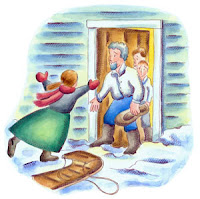
Perhaps a good neighbor, ready to help...
Whenever I need an exotic dose of color, pattern, or just a glimpse into a completely different way of life from here in North America, I visit Elizabeth's blog, The House in Marrakesh. (I wish I could smell the scents and feel the warm air through my computer, but that part is left to imagination...)
On Monday Elizabeth posted a collection of her door photographs-- a post which inspired a lot of interest in doors-- their design, their metaphors, their possibilities.
So next Wednesday, for fun, she's decided to have a "Door Day" theme. Post a picture of your favorite door, or do a drawing, or write something-- whatever inspires you. And maybe drop her a note to let her know. Everyone can play!



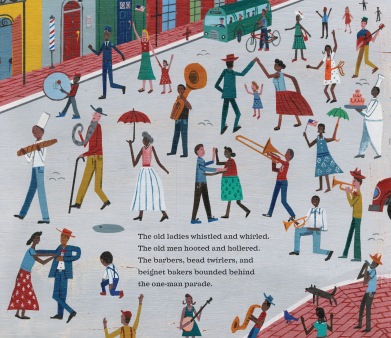


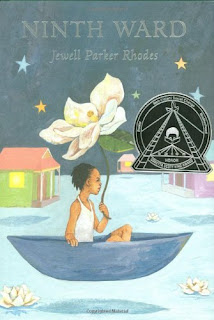


Oh wow. This sounds amazing. She sounds like the brave spirited kind of girl I would love my daughter to learn from. Great review.
Yes! I would love it if any child of mine grew up to be as compassionate, tough, and self-assured as Lanesha. YA lit needs more characters like her.
If you have time you should you should check out this read in. http://thehappynappybookseller.blogspot.com/2012/01/people-have-spoken-read-in.html
It starts on the 20th and we'll be discussing Ninth Ward.
I'm in! Thanks so much for letting me know about it!